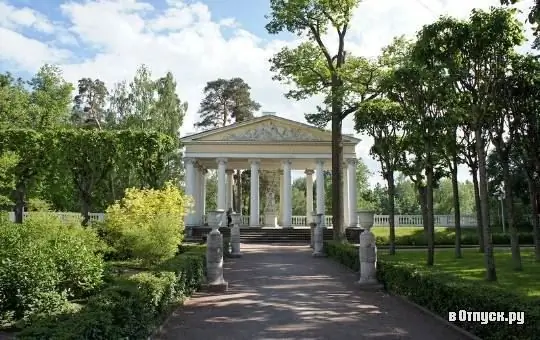
Description of the attraction
The Pavilion of the Three Graces is located in the Private Garden of the Central (Palace) District of Pavlovsky Park, right next to the palace. This is the last piece in Pavlovsk Park, created by the architect Charles Cameron in 1800.
The Pavilion of the Three Graces looks like an antique portico. The ceiling with large rosettes in the caissons is supported by sixteen slender Ionic columns. The pavilion has a gable roof with gables on both sides. When the Pavilion was being erected, sculptural compositions in tympans replaced the pediment statues. A relief depicting Apollo with the attributes of the arts and sciences was installed on the tympanum from the side of the Private Garden, and a relief depicting Minerva with military attributes on the side of Sadovaya Street. Their author was the sculptor Ivan Prokofievich Prokofiev.
On October 14, 1802, on her birthday, Maria Feodorovna received a gorgeous gift from her eldest son - the sculpture "Three Graces", representing three girls supporting a vase. 11,000 rubles were paid for it. The author of this group was the Italian sculptor Paolo Triscorni. Made from a single piece of marble.
From the moment this sculptural group was installed (1803) in the Pavilion, its name has also changed. Since the middle of the 19th century, in all archival materials, the building has been called the Pavilion of the Three Graces. Graces are goddesses who personify feminine charms, joy and beauty - Thalia (Color), Euphrosyne (Joy), Aglaya (Shine). They are the daughters of the god Zeus and the oceanid Eurynoma. Graces were often companions of the gods: Dionysus, Hermes, Aphrodite. Their main responsibility was to deliver to the gods and people everything that makes their life wonderful and happy.
The sculptural ensemble "Three Graces" gave the Pavilion an unusually light, transparent, poetic sound. It is in perfect harmony not only with Cameron's Colonnade, but also with the entire surrounding space.
During the Great Patriotic War, the sculptural group "Three Graces" was hidden, buried in the ground, but the Nazis managed to find it. By a happy coincidence, they did not have time to take it out.
In 1956-1957, under the direction of the architect Sofia Vladimirovna Popova-Gunich, the Pavilion of the Three Graces was restored.
Today, the Pavilion of the Three Graces is open to visitors. He still admires the beauty and grace of execution.







